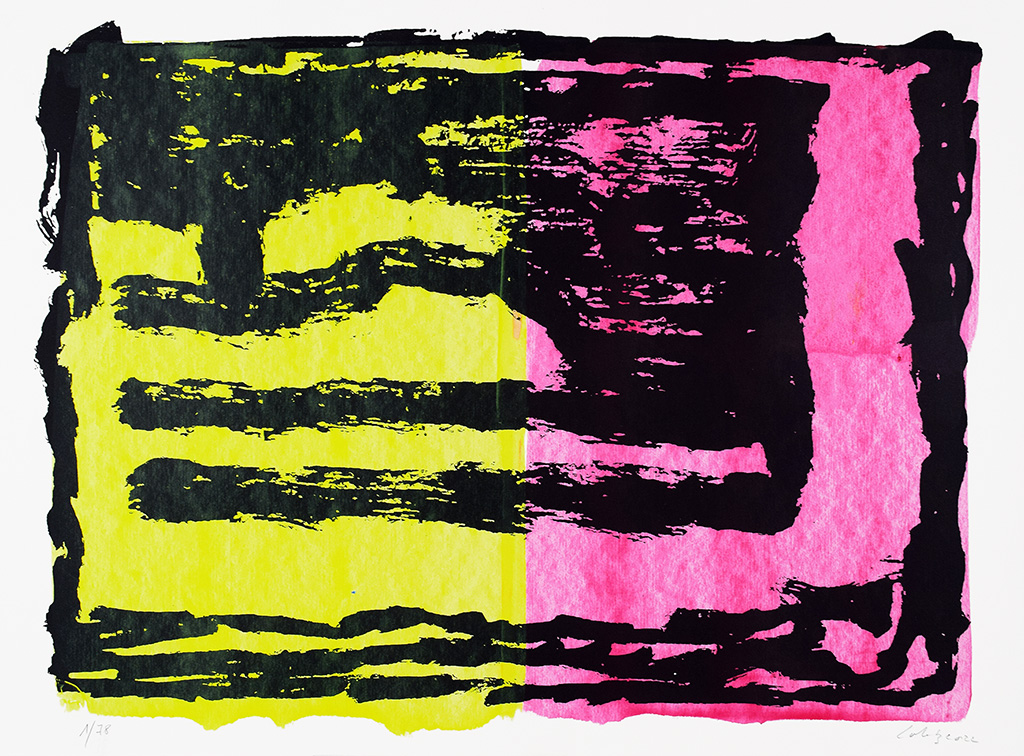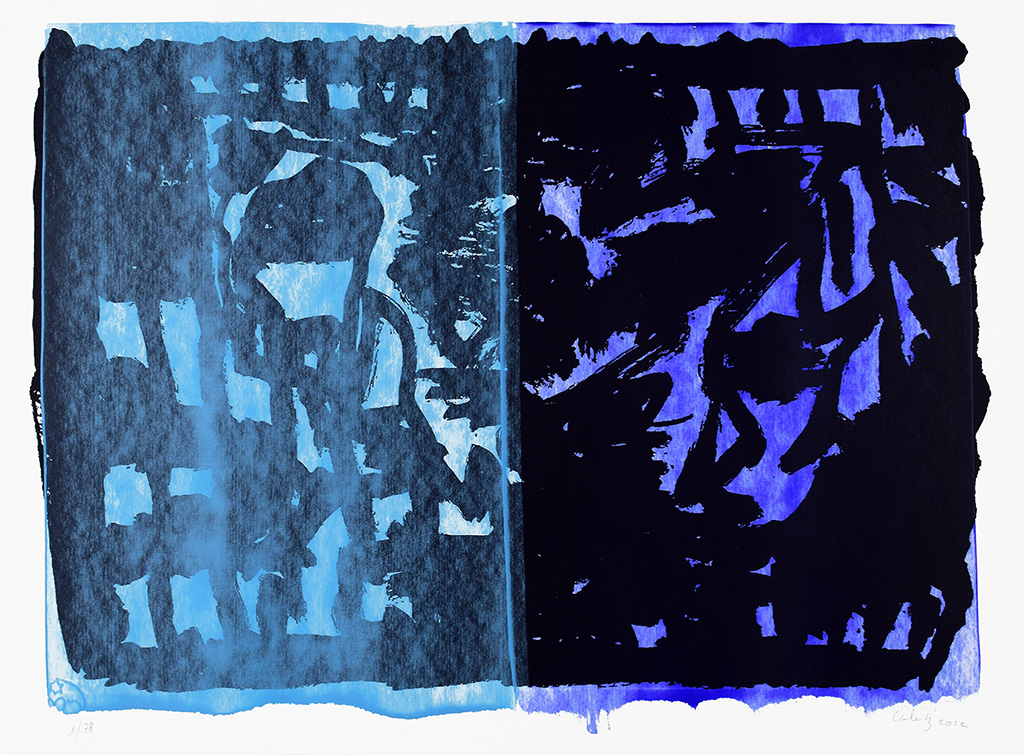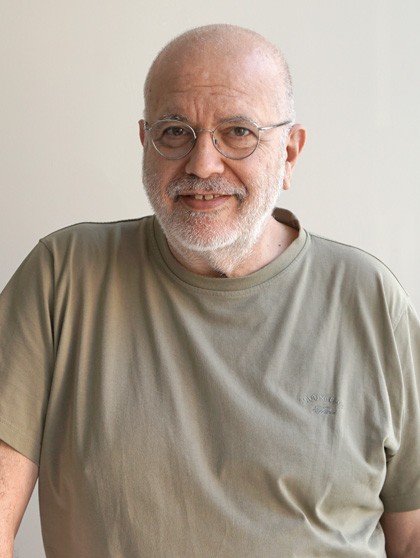
Pedro Calapez
Interview
Pedro Calapez (n.1953) é atualmente um dos artistas de maior notoriedade da sua geração. O seu trabalho tem sido alvo de mostras em diversas galerias e museus tanto em Portugal como no estrangeiro, estando representado em importantes coleções como o Museo Nacional Centro de Arte Reina Sofia em Madrid, o Museu de Serralves, no Porto, a Fundação EDP, a Fundação Calouste Gulbenkian e a Coleção da CGD em Lisboa, ou o Central European Bank, em Frankfurt e o Chase Manhattan Bank em Nova Iorque, entre outras coleções públicas e privadas.
Pedro Calapez (b.1953) is currently one of the most notorious artists of his generation. His work has been shown in several galleries and museums both in Portugal and abroad and is represented in important collections such as the Museo Nacional Centro de Arte Reina Sofía in Madrid, the Serralves Museum in Porto, the EDP Foundation, the Calouste Gulbenkian Foundation and the CGD Collection in Lisbon, the Central European Bank in Frankfurt and the Chase Manhattan Bank in New York, among other public and private collections.
We interviewed the artist on the occasion of the two new serigraphs made for the CPS, "Os Sonhos de Fausto" ("The Dreams of Fausto").
After the previous series, "Apanhados", tell us a little about this new series, "Os Sonhos de Fausto".
There is a certain continuity in terms of the technical process between the 2020 series “Apanhados” and this 2022 series that I titled “Os Sonhos de Fausto”. Everything has to do with work ideas realized in series. Situations often arise in which the basic work process turns out to have similarities, so to speak, even though they are different ideas.
I like to title my works. Before we had "Variações" (“Variations”), "Muros" (“Walls”), "Janelas" (“Windows”). After we had “Apanhados” ("Caught") and now “Os Sonhos de Fausto” ("The Dreams of Fausto"). References that recur or derive from what goes through my head at every moment.
These titles, which always appear a posteriori, are not intended to illustratively determine the images created, but there is something that the works evoke and makes me title each work or sequence of works.
With regard to “Apanhados”, we carried out an inkjet print that was then covered by a final print that is done manually, with a special spatula that ends up dragging a layer of ink over what is underneath. Always simulating the same gesture, but with slightly different results, we are almost in the field of monotype here. The imperfections, or rather the differences that can be noticed in a normal engraving edition, as there are always small situations of inking or paper displacement, or small pressure variations, are perhaps greater here, because they are the result of manual dragging, as mechanically as possible, of the spatula or squeegee on the surface of the paper. However, I do not consider these to be monotypes as the repetition side is always very present from the first layer of printing.
Pedro Calapez, "Os Sonhos de Fausto" Series, Silkscreen Print intervened with painting by the artist, 56 x 76 cm, series of 78, 2022
In “Apanhados” there is a strong obliteration of the image printed in the first place, creating a certain obscurity, which restricts the clear vision of what is underneath. In "Sonhos de Fausto", the two layers of paint on the initial image, obtained in this case by silkscreen printing, cause visual discrepancies due to the colours used and their transparencies. I should now mention that the first impression, both in one series and in the other, is obtained by digital drawings and paintings, therefore carried out on the computer and, while in "Apanhados" the image is completely digitally created, in "Sonhos de Fausto", it is based in drawings in China ink or black ink that come from my daily notebooks, which are then digitized and sized on the computer and a visualization of the final result is developed, by the inclusion of digital layers of colour, allowing the study of different visual options. Two of these drawings were chosen and then, here at CPS, some silkscreen tests were carried out. The two manual colours of the second layer create as if two planes on the drawing, a drawing that is very strong, with a thick and expressive line, revealing the “having been created freehand”, it is like a drawing coming from a pen or brush giant.
Pedro Calapez, "Os Sonhos de Fausto" Series, Silkscreen Print intervened with painting by the artist, 56 x 76 cm, series of 78, 2022
The point of the series, which now begins “Os Sonhos de Fausto”, has to do with recent readings of Faust by Goethe and also by Fernando Pessoa, although in the case of Pessoa, his Faust resulted from the combination of multiple of his notes and poems, which ended up resulting in two or three possibilities for a book, depending on the work of the various researchers, on how to order these fragments. Pessoa's Faust was not published as a book during his lifetime. But the versions that we have today reveal the connection with the idea of searching, of learning that obtaining knowledge is an unlimited task and that we do not know what lies beyond “total knowledge” and even so realize that it is not a matter of a search in vain, but a search that has no end.
Yes, it is an endless demand and it leads to another question. To what extent is the state, between dreaming and waking up, relevant to your visual creation?
About sleep and dreams, and from falling asleep to waking up, a lot happens. In fact, it is commonplace to say that when we wake up, ideas emerge as solutions to what concerns us. I often fall asleep thinking about how I am going to solve a certain matter, how my work is going to continue. It means that my brain will continue to function beyond the troubled dreams that shake me every night and that I remember little about when I wake up, and that in this way unpredictable paths are obtained in the creative process.
Hence, as this environment is present in my daily readings, the idea of using this title arose, as if these works were the result of a dream.
And in that state, you are neither awake nor asleep, and there is a possible answer to your questions.
When I wake up, I really remember, like most people, the end of the dreams, but then everything disappears and I no longer remember the story that came clear to me in the slow opening of my eyes. When you wake up during the night, sometimes you want to fall asleep again, continuing the story you're dreaming of. This happens to me many times, but sometimes I manage to continue, sometimes I don't. The ideas when waking up, some are good, others are useless (laughs). But anyway, they are ideas, we end up going around these situations that end up belonging to the creative process. They are part of it, they are not decisive, they are not its core, but it can be said that sometimes they help me a lot.
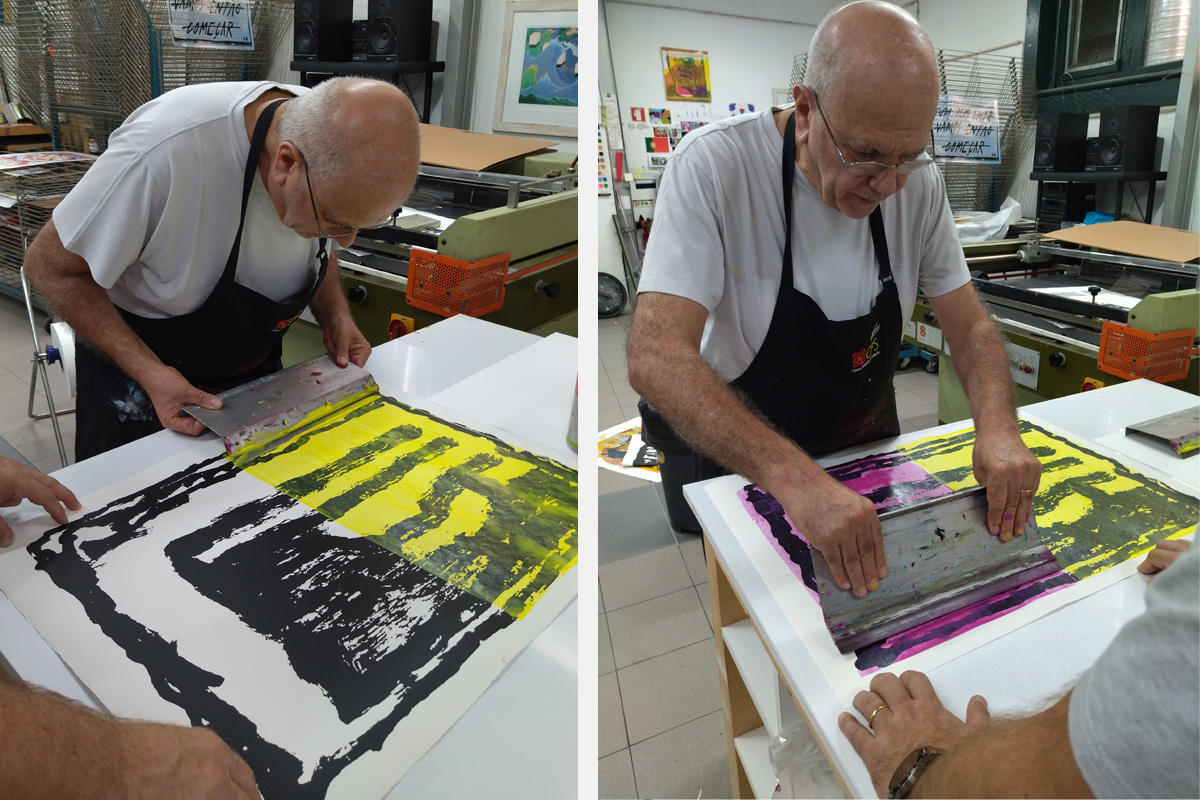
Pedro Calapez in the CPS Atelier. Manual Intervention with painting in the silkscreen prints previously printed.
I remembered “Guardador de Rebanhos”, from Fernando Pessoa's triumphal day, a similar situation in which he wrote this entire fabulous book from one end to the other.
Of Course. Out of curiosity I made a series of drawings and created a kind of poetic text by selectively removing some verses from “Guardador de Rebanhos”. So this side of using books, which has to do with picking up on things that unexpectedly interest me, where sometimes it's just a word or a line that stops me, is more important to me than being fully involved with a particular work, poem or stanza. But isn't this exactly what makes us read poetry?
Starting here from “Sonhos do Fausto”, the result is also an indefinable character, that is, the works do not have a nomination, they do not have time.
The idea is that there is a drawing and the drawing is on the limit between what is abstract and what could represent anything and that "anything" goes from an object to a landscape. Or the sense of construction: there is construction in the union or circulation of the thick lines, but everything is transformed into the planes of colour that flow over them. In the development of the work, it was fun to explore two different situations - as you know, if I had the time, I would have made a series of at least 10 different serigraphs to be, as you say, “intervened”.
Quando se olha uma e outra, no caso destas duas edições que agora terminámos, percebe-se bem que o efeito visual é completamente diferente. Enquanto uma é “noturna”, onde os azuis se continuam um no outro e criam um certo ambiente de obscurecimento, não diria espiritual, mas de reflexão introspetiva, a outra é “festiva”, muito mais contrastante e vibrante, é um contraste intenso entre duas cores. A cor acaba por estar a perturbar e quase a contrapor-se ao fundo. O desenho em impressão serigráfica. É esse o jogo, não é preciso complicar muito, há um trabalho que é visual e é no sentir das tensões entre os seus diferentes elementos que se estrutura cada obra. Os diferentes planos, o plano da serigrafia e o plano das duas cores estão visualmente em locais diferentes e o modo como se olha e como se vê essas diferentes movimentações da superfície caracteriza distintamente cada uma destas duas novas obras.
When you look at one and the other, in the case of these two editions that we have just finished, you can clearly see that the visual effect is completely different. While one is “nocturnal”, where the blues continue one into the other and create a certain atmosphere of obscuration, I would not say spiritual, but of introspective reflection, the other is “festive”, much more contrasting and vibrant, it is an intense contrast between two colours. The colour turns out to be disturbing and almost opposing the background, the design in serigraphic printing. That's the game, there's no need to complicate things too much, there's a work that is visual and it's in the sense of the tensions between its different elements that structure each work. The different planes, the silkscreen plane and the plane of the two colours are visually in different places and the way in which one looks and how one sees these different movements of the surface characterizes each of these two new works distinctly.
Although there is no such complication, in a way these works will also be projected on the spectator and on each spectator in a different way, so these works will have continuity in the gaze.
Claro, eu acho que esse é o objetivo da obra de arte. Uma obra de arte que não funciona só pelos sentidos, no entendimento que no imediato as cores excitam o nosso olhar. O que eu pretendo conseguir é que as imagens que eu vou produzindo, primeiramente em mim, porque estou a fazê-las, porque as estou a descobrir, sejam olhadas e que esse olhares consigam ligar-se a maneiras de pensar, que estas imagens provoquem dúvidas que sejam produtivas para pensamento de cada um. E isso provocará, como tu dizes reações diferentes. Não é uma história que se conta, esta história que as imagens contêm em si são definitivamente outra história.
Of course, I think that's the point of the artwork. A work of art that works not only for the senses, in the understanding that colours immediately excite our eyes. What I intend to achieve is that the images that I am producing, primarily in myself, because I am making them, because I am discovering them, are looked at and that these looks manage to connect to ways of thinking, that these images provoke questions that are productive for each one's thinking. And that will provoke, as you say, different reactions. It's not a story that is told, this story that the images contain in themselves is definitely another story.
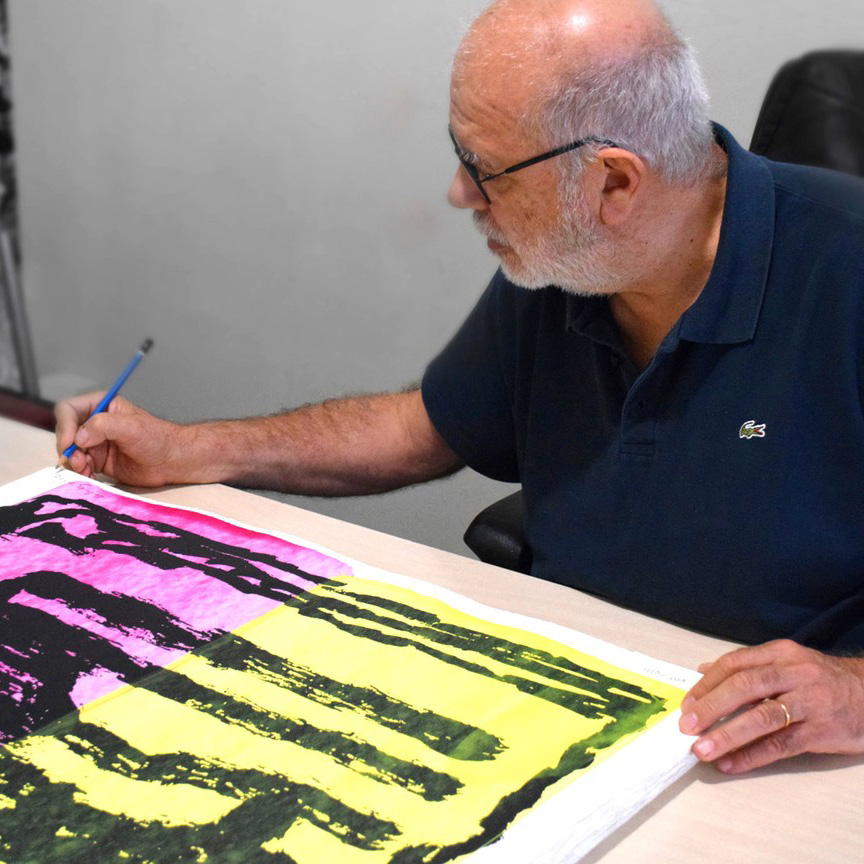
Numbering and signature session of the works with a final verification
It's a process of continuity, surely, and that can be generational. And here we dive a little into the universe of the members of the Centro Português de Serigrafia where we already have children and grandchildren of older Members, who will look at the same works or the previous works of their parents and grandparents in a different way and this transmission will remain. Here comes another question. What importance do you attribute to the multiple or the graphic work, considering that they have a broader spectrum of spectators?
The core of the graphic work, which is its multiplication, is to reach a greater number of people because, in addition to being able to see a work in a museum, they will be able to have a work in their home, which they can look at for two seconds every day. And since we are all different people and we don't all like the same things, putting together these generational differences, of father, children and grandchildren, implies that there is always something deep down that will touch everyone because even when you see a work that doesn't interest you a lot and causes you problems, it is questioning you, thus it is fulfilling its function. It's the most important.
This attitude that the CPS has, of training generations, has at least an enormous merit, as it passed, more than a certain image from parents to children, a teaching of the look, an individual and collective questioning.
The multiple, the graphic work, is for me as valid as any other form of plastic expression, as an original that is unique and of which there are no copies. Today there are copies of everything because everything multiplies too, this has to do with the images we see on cell phones, on television, in videogames. They are images that are available to us, free. There are certain works that can only be seen in the museum, but these works end up having, nowadays, such extraordinary dissemination through electronic media, that they provoke an immediate desire to accept that a work does not have to be unique, it is available for many people, it is part of the imaginary museum that we create in ourselves. Through the many existing media supports, it is transmuted into an object.
In the case of silkscreen prints and engravings, the multiplication by the edition number necessarily causes accessibility in terms of value, which further democratizes the issue of accessibility.
In CPS, as you know, editions are unrepeatable from the perspective of future appreciation.
Nothing is unrepeatable today (laughs), from the moment they appear in a magazine or were photographed in a cell phone message…
Your image will not be unrepeatable, but the editions, obviously linked to our deontology, are unrepeatable and we frame them in the so-called original graphic work, which in the end the artist, as is your case, is challenged to make a project which is an original to be multiplied.
I think there is only one case where I happened to make a drawing and it being reproduced out to be very similar to the original drawing. My serigraphs, engravings, do not have an original that produced them, the original is the engraving itself, as it originated in the graphic process itself, it was constructed and the reproduction is the image that is made by a mechanical process. It is often seen that there is an image and then its reproduction. I'm not saying there's anything wrong with that, many artists made drawings and then they were signed twice, by the author of the drawing and by the author of its transcription for the mechanical process. Matisse had a process: in some of the drawings he made, he used a specific pencil in such a way that, in this case, a lithographer, transcribed them through a process, I think of decal, for the transfer to the stone.
What I want to say is that there are always many people involved in the process and that this does not reduce the quality of the result, as long as it is properly controlled by the artist. In most of the works I make, the reproduction – it is already difficult to speak of an original when the originals are digital works – is dematerialized because in this case it is an electronic drawing, which is transformed to be printed. There are collectors who say “I have the original that gave rise to this edition”. In my case this is a difficult situation to achieve.
Deep down, art and in this specific case of our editions, will be aimed at a younger audience, what would you like to convey to collectors and appreciators of your work, thinking more about younger people, in a way, thinking about continuity and in the future of the gaze?
I don't really like making the distinction between young people and less young people, because people are young at any age. The notion of youth should include a predisposition to accept what is new, to question oneself in the face of what one is not understanding, and to accept and try to connect with what one is seeing: the youth of the look goes through these conditions. You can start at any age. Of course, the more time you have to be dazzled by what you are seeing is the most important thing. The more this practice is done in a natural way and without pressure of any kind, the closer we are to the “function” that art should have. In this sense, the “young” collectors will be the ones I always address.
Interview by João Prates, December, 2022
